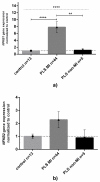Altered mRNA Expression of NFKB1 and NFKB2 Genes in Penile Lichen Sclerosus, Penile Cancer and Zoon Balanitis
- PMID: 36555871
- PMCID: PMC9784631
- DOI: 10.3390/jcm11247254
Altered mRNA Expression of NFKB1 and NFKB2 Genes in Penile Lichen Sclerosus, Penile Cancer and Zoon Balanitis
Abstract
Background: The nuclear factor-κB transcription factors 1 and 2 (NFKB1 and NFKB2) are key components of the NF-κB pathway, which responds to inflammatory signals. Since the NFKB1/2 factors are activated via different inflammatory molecules, we aimed to check their expression levels in penile cancer (PC), penile dermatoses: lichen sclerosus (PLS) and zoon balanitis (ZB).
Methods: Skin biopsies from altered and healthy looking foreskin were obtained from 59 (49 LS; early PLS: 13, moderate PLS: 32, severe PLS: 4; 6 PC; 4 ZB) and unchanged foreskin from 13 healthy control adult males undergoing circumcision. NFKB1/2 mRNA levels were quantified by qPCR.
Results: The highest levels of NFKB1 and NFKB2 were observed in PC, ca. 22 and 3.5 times higher than in control, respectively. NFKB1 expression was correlated with PLS progression (rs = 0.667) and was ca. 20 times higher in advanced PLS than in controls and early PLS. Occurrence of micro-incontinence was associated with elevated NFKB1 levels in PLS.
Conclusion: This is the first study regarding gene profiles of NFKB1/2 in PC and penile dermatoses. New drugs targeting modulation of canonical-activated NF-κB pathway should be studied and introduced to the treatment of PLS and PC apart from other treatments.
Keywords: NFKB1/2; penile cancer; penile lichen sclerosus; zoon balanitis.
Conflict of interest statement
The authors declare no conflict of interest.
Figures



Similar articles
-
The role of occlusion and micro-incontinence in the pathogenesis of penile lichen sclerosus: an observational study of pro-inflammatory cytokines' gene expression.Int Urol Nephrol. 2022 Apr;54(4):763-772. doi: 10.1007/s11255-022-03130-7. Epub 2022 Feb 1. Int Urol Nephrol. 2022. PMID: 35103930 Free PMC article.
-
Circumcision and genital dermatoses.Arch Dermatol. 2000 Mar;136(3):350-4. doi: 10.1001/archderm.136.3.350. Arch Dermatol. 2000. PMID: 10724196
-
Penile Inflammatory Skin Disorders and the Preventive Role of Circumcision.Int J Prev Med. 2017 May 4;8:32. doi: 10.4103/ijpvm.IJPVM_377_16. eCollection 2017. Int J Prev Med. 2017. PMID: 28567234 Free PMC article. Review.
-
Recent advances in understanding and managing Lichen Sclerosus.F1000Res. 2020 May 15;9:F1000 Faculty Rev-369. doi: 10.12688/f1000research.21529.1. eCollection 2020. F1000Res. 2020. PMID: 32518626 Free PMC article. Review.
-
Penile lichen sclerosus (balanitis xerotica obliterans).BJU Int. 2011 Nov;108 Suppl 2:14-9. doi: 10.1111/j.1464-410X.2011.10699.x. BJU Int. 2011. PMID: 22085120 Review.
Cited by
-
Inflammation in Penile Squamous Cell Carcinoma: A Comprehensive Review.Int J Mol Sci. 2025 Mar 19;26(6):2785. doi: 10.3390/ijms26062785. Int J Mol Sci. 2025. PMID: 40141426 Free PMC article. Review.
-
Single-Cell RNA Sequencing Reveals a Unique Fibroblastic Subset and Immune Disorder in Lichen Sclerosus Urethral Stricture.J Inflamm Res. 2024 Aug 13;17:5327-5346. doi: 10.2147/JIR.S466317. eCollection 2024. J Inflamm Res. 2024. PMID: 39157587 Free PMC article.
-
Exploring the Multifactorial Landscape of Penile Cancer: A Comprehensive Analysis of Risk Factors.Diagnostics (Basel). 2024 Aug 16;14(16):1790. doi: 10.3390/diagnostics14161790. Diagnostics (Basel). 2024. PMID: 39202278 Free PMC article. Review.
-
Pro-Inflammatory Cytokine Gene Expression in Penile Cancer: Preliminary Studies.Medicina (Kaunas). 2023 Sep 8;59(9):1623. doi: 10.3390/medicina59091623. Medicina (Kaunas). 2023. PMID: 37763742 Free PMC article.
-
NFKB1 as a key player in Tumor biology: from mechanisms to therapeutic implications.Cell Biol Toxicol. 2025 Jan 11;41(1):29. doi: 10.1007/s10565-024-09974-2. Cell Biol Toxicol. 2025. PMID: 39797972 Free PMC article. Review.
References
LinkOut - more resources
Full Text Sources
Miscellaneous

